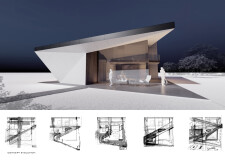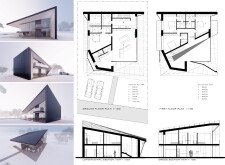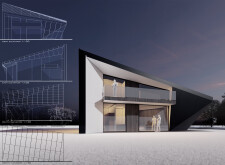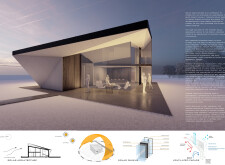5 key facts about this project
## Overview
The residential structure located in [specific location] exemplifies a modern approach to sustainable living through innovative design and strategic material use. The project emphasizes solar architectural principles, aimed at reducing reliance on fossil fuels and minimizing greenhouse gas emissions. By integrating renewable energy systems and ensuring comfort through efficient insulation, the design reflects a commitment to ecological responsibility while maintaining contemporary aesthetics.
### Architectural Form and Materiality
This structure features a distinctive geometric form characterized by sharp angles and a cantilevered roof, which contributes to both visual interest and practical functionality. The roof's overhang not only enhances the exterior aesthetics but also serves to shade outdoor spaces, reducing energy costs associated with heating and cooling. The building's facade employs a mix of high-performance glass, insulated panels, and timber accents, creating a harmonious interplay of textures. The glass facilitates natural light penetration and blurs the boundaries between indoor and outdoor environments, while the timber provides warmth to the overall composition.
### Spatial Organization and User Experience
Interior spaces are thoughtfully organized to optimize functionality and flow. The ground floor presents an open-plan layout that integrates living, kitchen, and dining areas, promoting social interaction and connectivity. The upper level is dedicated to private spaces, including bedrooms and bathrooms, ensuring privacy without sacrificing cohesion. The strategic placement of windows not only capitalizes on scenic views but also enhances natural lighting throughout the home. Outdoor features like balconies and patios extend the usable space, fostering versatile environments for relaxation and recreation.
This architectural design incorporates durable, fire-resistant materials, ensuring long-term safety and resilience while promoting environmental responsiveness through adaptive architecture, making it a significant contribution to sustainable residential practices.





















































